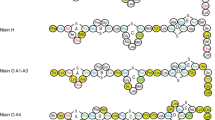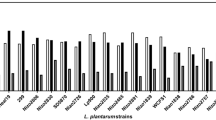Abstract
We previously reported the production of limited quantities of biologically active recombinant human lactoferrin in the filamentous fungus, Aspergillus oryzae. In the present study, we report a modification of this production system combined with a classical strain improvement program that has enabled production of levels of recombinant human lactoferrin in excess of 2 g/l. The protein was expressed in Aspergillus awamori as a glucoamylase fusion polypeptide which was secreted into the growth medium and processed to mature human lactoferrin by an endogenous KEX-2 peptidase. The recombinant protein retains full biological activity in terms of its ability to bind iron and human enterocyte receptors. Furthermore, the recombinant protein functions as a potent broad spectrum antimicrobial protein.
This is a preview of subscription content, access via your institution
Access options
Subscribe to this journal
Receive 12 print issues and online access
$209.00 per year
only $17.42 per issue
Buy this article
- Purchase on Springer Link
- Instant access to full article PDF
Prices may be subject to local taxes which are calculated during checkout
Similar content being viewed by others
References
Masson, P.L. and Heremans, J.F. 1971. Lactoferrin in milk from different species. Comp. Biochem. Physiol. 39: 119–129.
Hennart, P.F., Brasseur, D.J., Delogne-Desnoeck, I.B., Dramaix, M.M. and Robyn, C.E. 1991. Lysozyme, lactoferrin and secretory immunoglobin A content in breast milk: Influence of duration of lactation, nutrition status, prolactin status, and parity of mother. Am. J. Clin. Nutr. 53: 32–39.
Masson, P.L., Heremans, J.F. and Dive, C. 1966. An iron-binding protein common to many external secretions. Clin. Chim. Acta. 14: 735–739.
Pentecost, B.T. and Teng, C.T. 1987. Lactotransferrin is the major estrogen inducible protein of mouse uterine secretions. J. Biol. Chem. 262: 10134–10139.
Yu, L.-C. and Chen, Y.-H. 1993. The developmental profile of lactoferrin. Biochem. J. 296: 107–111.
Masson, P.L., Heremans, J.F. and Schonne, E. 1969. Lactoferrin, an iron-binding protein in neutrophilic leukocytes. J. Exp. Med. 130: 643–658.
Anderson, B.F., Baker, H.M., Morris, G.E., Rice, D.W. and Baker, E.N. 1989. Structure of human lactoferrin: Crystallographic structure analysis and refinement at 2.8A resolution. J. Mol. Biol. 209: 711–734.
Anderson, B.F., Baker, H.M., Morris, G.E., Rumball, S.V. and Baker, E.N. 1990. Apolactoferrin structure demonstrates ligand-induced conformational change in transferrins. Nature 344: 784–787.
Sanchez, L., Calvo, M. and Brock, J.H. 1992. Biological role of lactoferrin. Arch. Dis. Child. 67: 657–661.
Iyer, S. and Lonnerdal, B. 1993. Lactoferrin, lactoferrin receptors and iron metabolism. Eur. J. Clin. Nutr. 47: 232–241.
Oram, J.D. and Reiter, B. 1968. Inhibition of bacteria by lactoferrin and other iron-chelating agents. Biochem. Biophys. Acta. 170: 351–365.
Arnold, R.R., Brewer, M. and Gauthier, J.J. 1980. Bactericidal activity of human lactoferrin: Sensitivity of a variety of microorganisms. Infect. Immun. 28: 893–898.
Trumpler, U., Straub, P.W. and Rosenmund, A. 1989. Antibacterial prophylaxis with lactoferrin in neutropenic patients. Eur. J. Clin. Microbiol. Infect. Dis. 8: 310–313.
Zagulski, T., Lipinski, P., Zagulska, A., Broniek, S. and Jarzabek, Z. 1989. Lactoferrin can protect mice against a lethal dose of Escherichia coli in experimental infection in vivo. Br. J. Exp. Pathol. 70: 697–704.
Bishop, J.A., Schanbacher, F.L., Ferguson, L.C. and Smith, K.L. 1976. In vitro growth inhibition of mastitis causing coliform bacteria by bovine apolactoferrin and reversal of inhibition by citrate and high concentrations of apolactoferrin. Infect. Immun. 14: 911–918.
Bullen, J.J., Rogers, H.J. and Griffiths, E. 1978. Role of iron in bacterial infection. Curr. Top. Microbiol. Immunol. 80: 1–35.
Reiter, B. 1978. Review of non-specific and microbial factors in milk. Ann. Rech. Vet. 9: 205–224.
Arnold, R.R., Cole, M.F. and McGhee, J.R. 1977. A bactericidal effect for human lactoferrin. Science 197: 263–265.
Bellamy, W., Takase, M., Yamauchi, K., Wakabayashi, H., Kawase, K. and Tomita, M. 1992. Identification of the bactericidal domain of lactoferrin. Biochem. Biophys. Acta. 1121: 130–136.
Ellison, R.T., Giehl, T.-J. and LaForce, F.M. 1988. Damage of the outer membrane of enteric Gram-negative bacteria by lactoferrin and transferrin. Infect. Immun. 56: 2774–2781.
Yamauchi, K., Tomita, M., Giehl, T.J. and Ellison, R.T. 1993. Antibacterial activity of lactoferrin and a pepsin-derived lactoferrin peptide fragment. Infect. Immun. 61: 719–728.
Mazurier, J., Legrand, D., Hu, W.-L., Montreuil, J. and Spik, G. 1989. Expression of human lactotransferrin receptors in phytohemagglutinin stimulated human peripheral blood lymphocytes: Isolation of the receptors by antiligand-affinity chromatography. Eur. J. Biochem. 179: 481–487.
Birgens, H.S., Hansen, N.E., Karle, H. and Kristensen, L.O. 1983. Receptor binding of lactoferrin by human monocytes. Br. J. Haematot. 54: 383–391.
van Snick, J.L. and Masson, P.L. 1976. The binding of human lactoferrin to mouse peritoneal cells. J. Exp. Med. 144: 1568–1580.
Leveugle, B., Mazurier, J., Legrand, D., Mazurier, C., Montreuil, J. and Spik, G. 1993. Lactotransferrin binding to its platelet receptor inhibits platelet aggregation. Eur. J. Biochem. 213: 1205–1211.
Machnicki, M., Zimecki, M. and Zagulski, T. 1993. Lactoferrin regulates the release of tumour necrosis factor alpha and interleukin 6 in vivo. Int. J. Exp. Path. 74: 433–439.
Crouch, S.P.M., Slater, K.J. and Fletcher, J. 1992. Regulation of cytokine release from mononuclear cells by the iron-binding protein lactoferrin. Blood 80: 235–240.
Cox, T.M., Mazurier, J., Spik, G., Montreuil, J. and Peters, T.J. 1979. Iron binding proteins and influx of iron across the duodenal brush border. Evidence for specific lactotransferrin receptors in the human intestine. Biochem. Biophys. Acta. 558: 129–141.
Ward, P.P., May, G.S., Headon, D.R. and Conneely, O.M. 1992. An inducible expression system for the production of human lactoferrin in Aspergillus niduslans. Gene 122: 219–223.
Ward, P.P., Lo, J.-Y., Duke, M., May, G.S., Headon, D.R. and Conneely, O.M. 1992. Production of biologically active recombinant human lactoferrin in Aspergillus oryzae. Bio/Technology 10: 784–789.
Jeenes, D.J., Mackenzie, D.A., Roberts, I.N. and Archer, D.B. 1991. Heterologous protein production by filamentus fungi. Biotech. Gen. Eng. Rev. 9: 327–367.
Dunn-Coleman, N.S., Bloebaum, P., Berka, R.M., Bodie, E., Robinson, N., Armstrong, G., Ward, M., Przetak, M., Carter, G.L., LaCost, R., Wilson, L.J., Kodama, K.H., Bower, B., Lamsa, M. and Heinsohn, H. 1991. Commercial levels of chymosin production by Aspergillus. Bio/Technology 9: 976–981.
Ward, M., Wilson, L.J., Kodama, K.H., Rey, M.W. and Berka, R.M. 1990. Improved production of chymosin in Aspergillus by expression as a glucoamylase-chymosin fusion. Bio/Technology 8: 435–440.
Jeenes, D.J., Mackenzie, D.A. and Archer, D.B. 1993. A truncated glucoamylase gene fusion for heterologous protein secretion from Aspergillus niger. FEMS Microbiol. Lett. 107: 267–272.
Devchand, M., Gwynne, D., Buxton, F. and Davies, R. 1989. An efficient cell-free translation system from Aspergillus nidulans and in vitro translocation of prepro-a mating factor across Aspergillus microsomes. Curr. Genet. 14: 561–566.
Vilja, P., Krohn, K. and Tuohimaa, P. 1985. A rapid and sensitive noncompetitive avidin-biotin assay for lactoferrin. J. Immunol. Meth. 76: 73–83.
Spik, G., Coddenville, B. and Montreuil, J. 1988. Comparative study of the primary structures of sero-, lacto- and ovatransferrin glycans from different species. Biochem. 70: 1459–1469.
Pinto, M., Robine-Leon, S., Appay, M.-D., Kedinger, M., Triadou, N., Dussaulx, E., Lacroix, B., Simon-Assmann, P., Haffer, K., Fogh, J. and Zweibaum, A. 1983. Enterocyte-like differentiation and polarization of the human colon carcinoma cell line Caco-2 in culture. Biol. Cell. 47: 323–330.
Scatchard, G. 1949. The attractions of proteins for small molecules and ions. Ann. NY Acad. Sci. 51: 660–672.
Clark, J.H., Mitchell, W.C. and Guthrie, S.C. 1986. Triphenylethylene antiestrogen binding sites (TABS) specificity. J. Steroid Biochem. 26: 433–437.
Metz-Boutigue, M.-H., Jolles, J., Mazurier, J., Schoertger, F., Legrand, D., Spik, G., Montreuil, J. and Jolles, P. 1984. Human lactotransferrin: amino acid sequence and structural comparisons with other transferrins. Eur. J. Biochem. 145: 659–676.
Kawakami, H. and Lonnedal, B. 1991. Isolation and function of a receptor for human lactoferrin in human fetal intestinal brush-border membrane. Am. J. Physiol. 261: G841–G846.
Derisbourg, P., Wieruszeski, J.-M., Montreuil, J. and Spik, G. 1990. Primary structure of glycans isolated from human leucocyte lactotransferrin. Absence of fucose residues questions the propoesed mechanism of hyposideraemia. Biochem. J. 269: 821–825.
Saunders, G., Picknett, T.M., Tuite, M.F. and Ward, M. 1989. Heterologous gene expression in filamentous fungi. Trends in Biotechnol. 7: 283–287.
Contreras, R., Carrez, D., Kinghorn, J.R., van der Hondel, C.A.M.J.J. and Pier, W. 1991. Efficient KEX2-like processing of a glucoamylase-interleukin-6 fusion protein by Aspergillus nidulans and secretion of mature interleukin 6. Bio/Technology 9: 378–381.
Nunberg, J.H., Meade, J.H., Cole, G., Lawyer, F.C., McCabe, P., Schweickart, V., Tal, R., Wittman, V.P., Flatgaard, J.E. and Innis, M.A. 1984. Molecular cloning and characterization of the glucoamylase gene of Aspergillus awamori. Mol. Cell. Biol. 4: 2306–2315.
Boel, E., Hansen, M.T., Hjort, L., Hoegh, I. and Fill, N.P. 1984. Two different types of intervening sequences in the glucoamylase gene from Aspergillus niger. EMBO J. 3: 1581–1585.
Gangnol, A. 1987. Phleomycin resistance encoded by the ble gene. Mol. Gen. Genet. 207: 342–348.
Tilbura, J., Scazzocchio, C., Taylor, G.G., Zabicky-Zissima, J.H., Lockington, R.A. and Davis, R.W. 1983. Transformation by integration in Aspergillus nidulans. Gene 26: 205–221.
Carboral, J.M., Diez, B., Barredo, J.L., Alvarez, E. and Martin, J.F. 1987. High frequency transformation of penicilliun chrysogeneum. Bio/Technology 5: 494–497.
Masson, P.L. and Heremans, J.F. 1968. Metal-combining properties of human lactoferrin (Red Milk Protein). 1. The involvement of bicarbonate in the reaction. Eur. J. Biochem. 6: 579–584.
Stowell, K.M., Rado, T.A., Funk, W.D. and Tweedie, J.W. 1991. Expression of cloned human lactoferrin in baby-hamster kidney cells. Biochem. J. 276: 349–355.
Rejman, J.J., Turner, J.D. and Oliver, S.P. 1994. Characterization of lactoferrin binding to the Mac-T bovine mammary epithelial cell line using a biotin-avidin technique. Int. J. Biochem. 26: 201–206.
Author information
Authors and Affiliations
Rights and permissions
About this article
Cite this article
Ward, P., Piddington, C., Cunningham, G. et al. A System for Production of Commercial Quantities of Human Lactoferrin: A Broad Spectrum Natural Antibiotic. Nat Biotechnol 13, 498–503 (1995). https://doi.org/10.1038/nbt0595-498
Received:
Accepted:
Issue Date:
DOI: https://doi.org/10.1038/nbt0595-498
This article is cited by
-
Cellular agriculture for milk bioactive production
Nature Reviews Bioengineering (2023)
-
A Novel Human Recombinant Lactoferrin Inhibits Lung Adenocarcinoma Cell Growth and Migration with No Cytotoxic Effect on Normal Human Epithelial Cells
Archivum Immunologiae et Therapiae Experimentalis (2021)
-
Comparative genomic analysis identified a mutation related to enhanced heterologous protein production in the filamentous fungus Aspergillus oryzae
Applied Microbiology and Biotechnology (2016)
-
Expression of recombinant human lactoferrin in transgenic alfalfa plants
Biologia plantarum (2013)
-
Transgenic expression of lactoferrin imparts enhanced resistance to head blight of wheat caused by Fusarium graminearum
BMC Plant Biology (2012)



